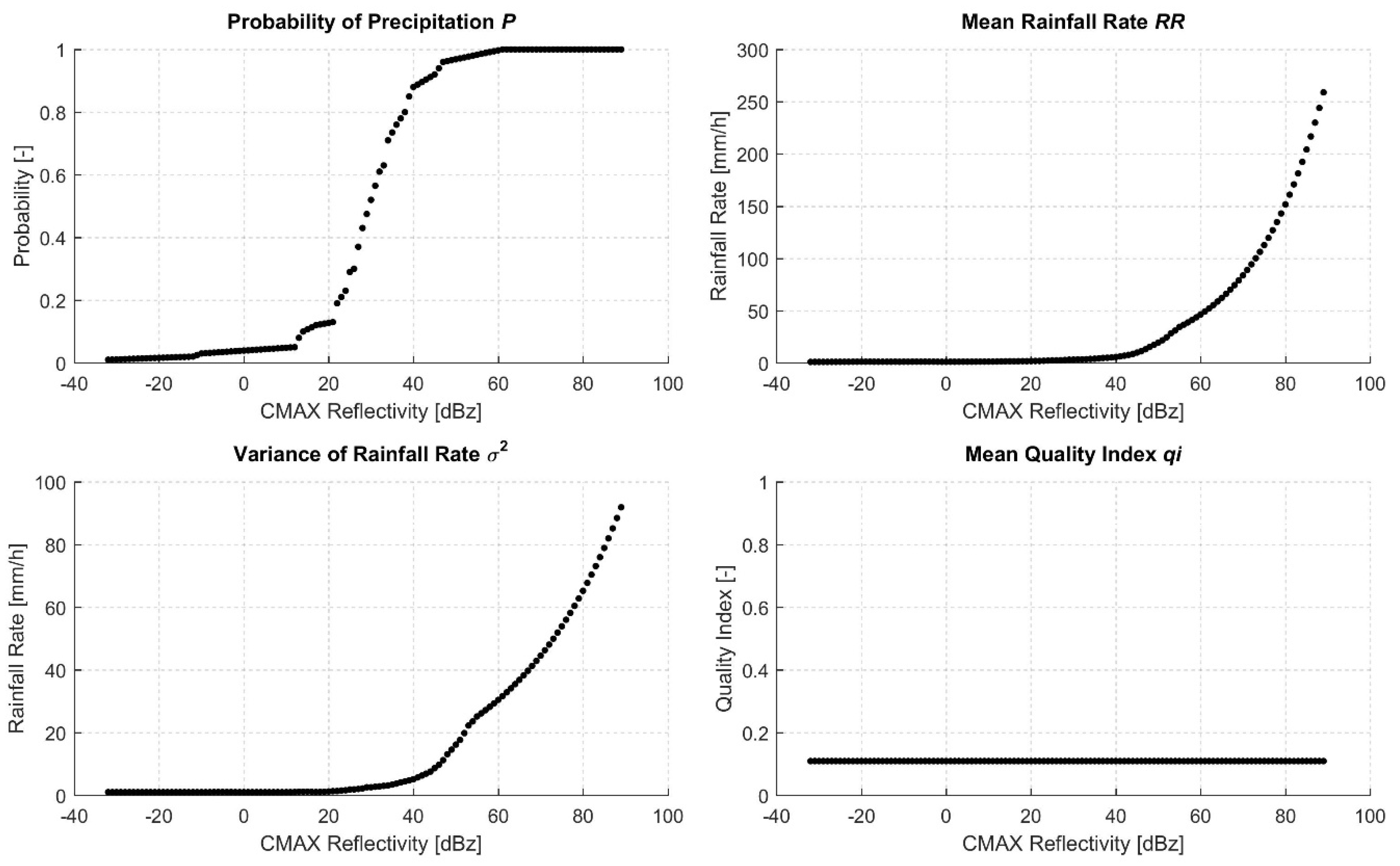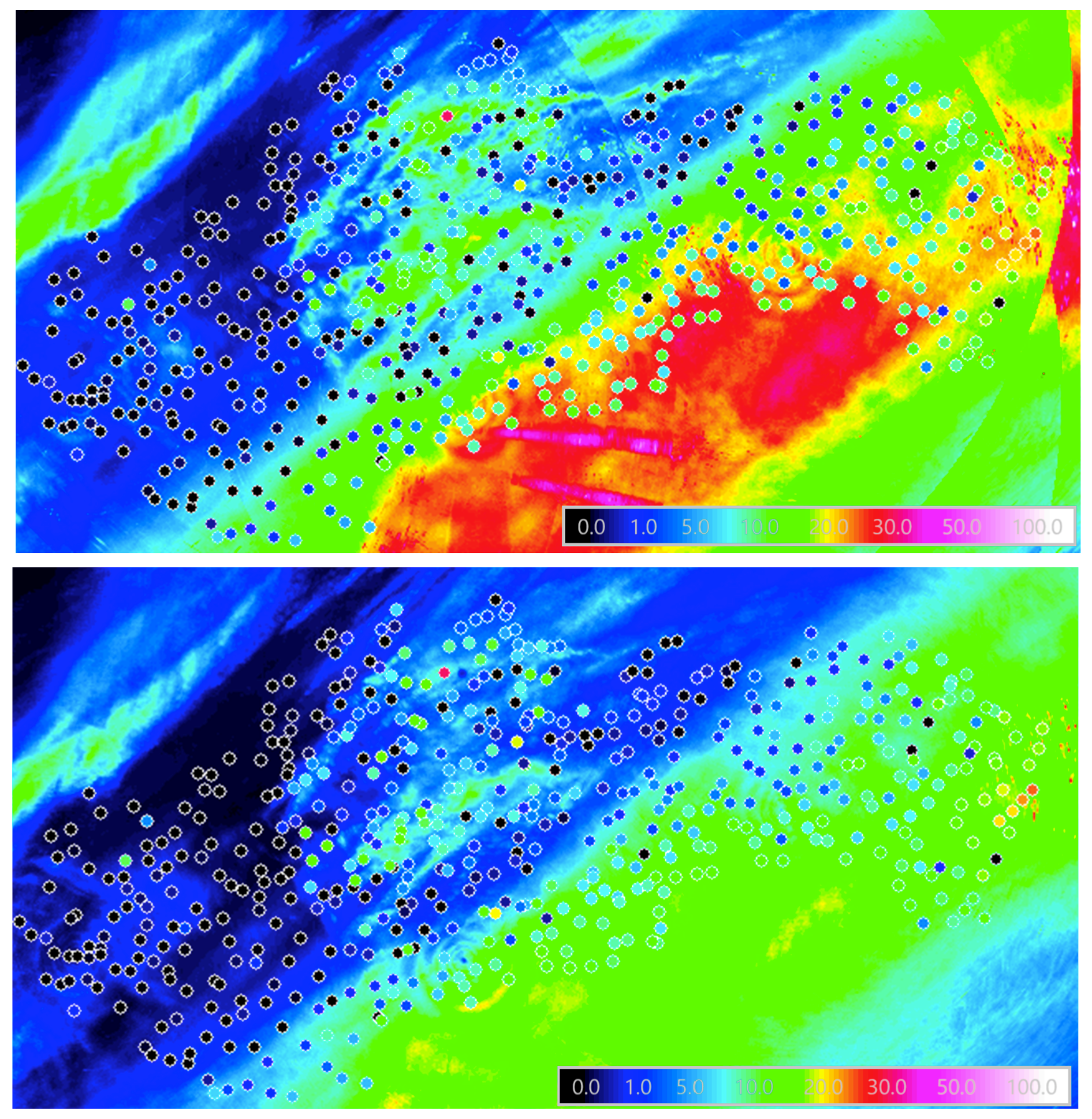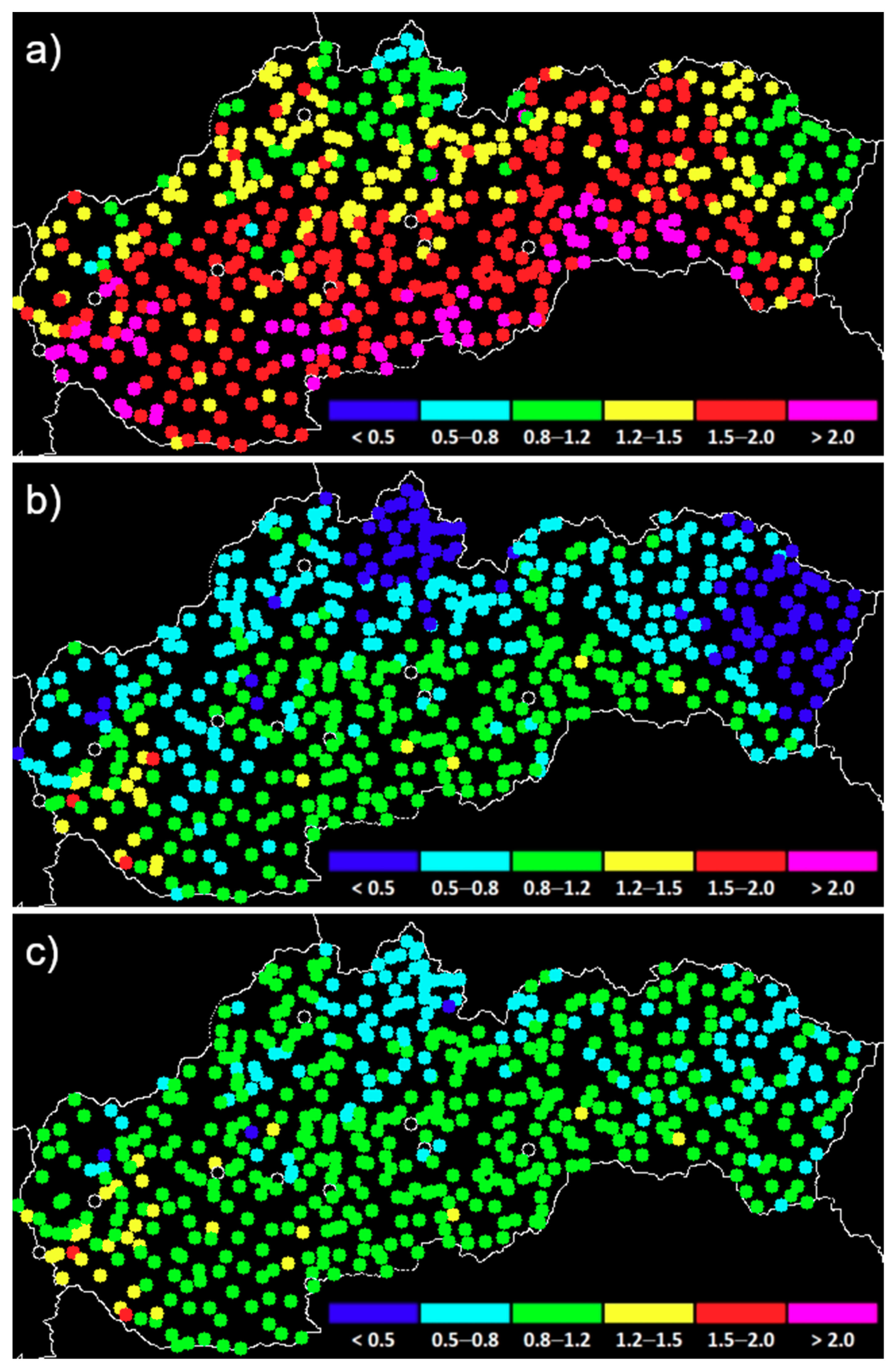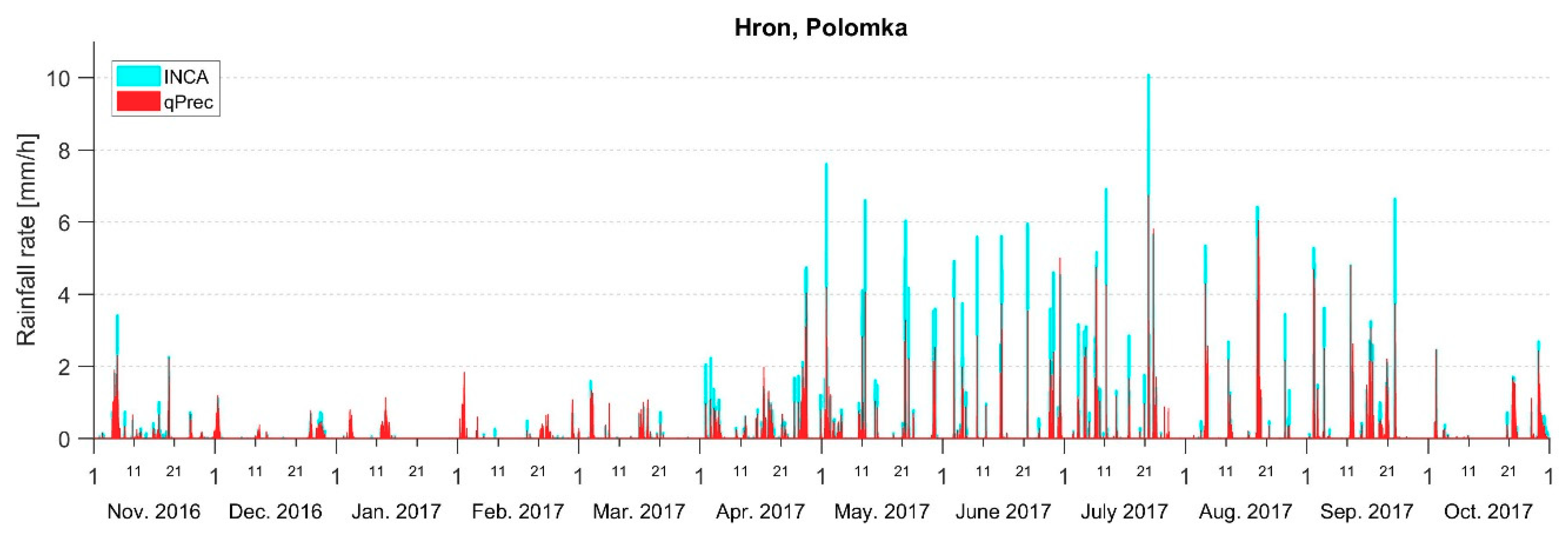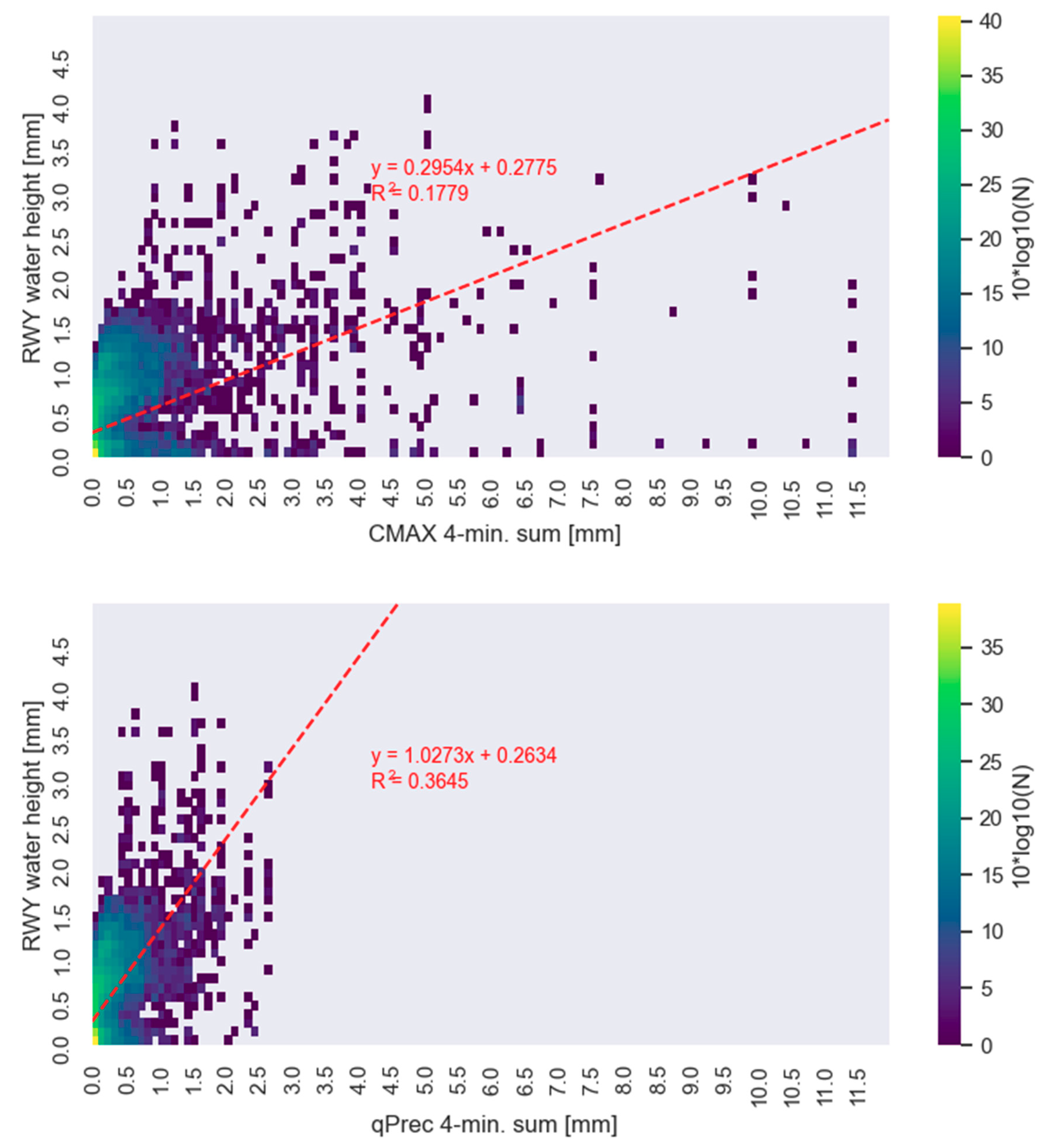1. Introduction
Meteorological radars are an important part of the everyday practice of weather and aviation professionals and have a direct impact on public welfare. They provide valuable information on the hydrometeor-related atmospheric processes and cover various spatial and temporal scales: the movement of weather systems, genesis/evolution/decomposition of cloud systems, rainfall rates, form and phase of hydrometeors, etc. [
1,
2,
3], and all of these are essential inputs in forecasting/nowcasting models [
4]. One of the most significant drawbacks of radar-based observations is the questionable precision of the rainfall amount estimation, in comparison with the true amounts measured by a ground-based network of rain gauges [
5]. Practically, one of the most essential goals of radar meteorology is adjusting the inherently imprecise radar measurements to the spatially relatively sparse gauge-based information on rainfall [
6].
More radars (i.e., an increase in quantity) do not necessarily imply better rainfall estimates (i.e., an increase in quality). Nevertheless, with correctly chosen approaches to creating radar composites (i.e., overlapping images from different radars), one can also enhance the quality of the radar information [
7,
8,
9]. Homogeneous radar composites over larger areas or locally in complex terrain, created from a heterogeneous radar network, provide up-to-date information on meteorological processes in the lower air-space. Observations and, more importantly, nowcasting of thunderstorms allow for the strategic planning of airport operations and flight routes. Increased situational awareness contributes to safety, particularly during landing or take-off, for instance in minimizing the risk of runway excursions. These are the most frequent type of runway safety accidents—they add up to 25% of all accidents over the 2015–2019 period according to 2019 Safety Report of the International Air Transport Association [
10]. Additionally, preparedness and ability to cope with unexpected situations and/or adverse weather events [
11] results in optimized operating schedules, which save fuel, reduce delays, minimize diversions (e.g., [
12]), and, thus, reduce costs and decrease the greenhouse gas emissions. The improved radar composites may, therefore, indirectly increase efficiency and enhance sustainability of the air traffic management.
High quality radar information is particularly preferred in aviation; thus, aircraft are currently compulsorily equipped with airborne radars. These instruments, however, have limited power, and therefore, are only able to cover a shorter range ahead of the aircraft. Radar composites, on the other hand, offer more detailed information regarding the meteorological conditions within a much wider range along the flight route and in the vicinity of the target airport.
There are a number of verified and approved methods for constructing radar composites in the scientific literature, either on the level of cases studies or in the form of implemented algorithms from the operative practice of hydrometeorological services. Nevertheless, radar manufacturers generally do not devote dedicated attention to the issue of compositing, as they primarily focus on the single-radar algorithms. This is, on one hand, logical, since well-functioning single radars are the necessary condition of any radar networking. On the other hand, this is a topic that requires a more elaborate approach mainly in the light of increased demands for radar data within pan-European data exchange and co-operation [
7,
8,
9].
One of the basic dilemmas when evaluating data from more than one radars (
N > 1) at a given point (pixel, bin) is how to treat the multiplicity of the reflectivity information
Zi,
i = 1, …,
N. There are different, generally accepted methods: to take the maximum value of the available reflectivity
Zi, to estimate the mean reflectivity, or to compute some weighted average of the
Zi values. In the latter case, the definition of the appropriate weights offers plenty of further alternatives to cope with the problem: for instance, with the weighting factors being inversely proportional to the distance of the given pixel from each radar, with the inclusion of the actual height of the radar beam above the ground within the target pixel, or with the combination of these or further variables. Jurczyk et al. [
13] presented a substantial overview of the pros and cons of different compositing methods and emphasized that the weights might also express the quality of the data from the contributing radars.
The quality of the radar measurements may be expressed through quality information or quality indices (QI, [
14]). Beyond the meteorological targets and its effects (e.g., bright band), the radar signal is affected by a number of further factors stemming from the technological construction of the radar itself, the geomorphological character of the surrounding area (e.g., ground clutter, beam blocking), different non-meteorological targets (e.g., birds, insects, interfering wi-fi signals), the parameter settings of the particular radar scan (height of the radar beam above the target points, the age of the reflectivity information within a given scan), etc. The effect of all these factors may be converted into mathematical form as quality indices, and the combination of these phenomena-related, particular QIs might be understood as the overall quality index of the given radar [
15]. There is no general convention regarding how to define and/or how to use the different QIs—their usage depends on the goals of the research teams or the operational requirements of the hydrometeorological services [
13,
16,
17,
18,
19,
20,
21,
22,
23].
A common measure of the quality of the QI-based estimation is some visual improvement in the layout of the radar composites. Visual impressions are subjective, and they are hard to quantify; thus, the benefits of the QI-based approaches are usually evaluated indirectly, through the improvement of the performance of various statistical, weather forecasting, or hydrological models. Such a category of statistical models is quantitative precipitation estimation (QPE). It is beyond the goals of the current study to present an overview of the methods of radar-based QPE [
4]; however, we can mention a couple of works especially devoted to QI-based QPE. Szturc et al. [
20,
21] developed a method of QPE in a probabilistic framework. Their concept assumes that the probability density function (PDF) of the rainfall amounts (rates) can be approximated by the two-parameter gamma distribution, where the parameters of the PDF are functions of the radar deterministic measurement
R and the quality index QI. With the estimated PDF parameters for each pixel, ensembles of precipitation fields can be generated, which further serve as inputs for hydrological modeling [
21]. Zhang et al. [
24] developed QI-based QPE for the national network of polarimetric radars in China with QIs based mostly on polarimetric parameters.
The current paper was motivated by the development of two inter-related software packages,
qRad and
qPrec, that were built to take advantage of the quality information from the available C-band radar measurements. The software packages follow the recent trends in the development of radar applications and are in line with the recommendations of the OPERA program (Operational Programme for the Exchange of Weather Radar Information) of the EUMETNET (Network of European Meteorological Services) [
9]. The developed software can indicate noticeable results in the fields of operative meteorological or hydrological practice, with the potential for use in aviation meteorology. The benefits of the
qRad software are represented by improved radar composites to better aid air navigation and safety, whereas those of the
qPrec software are manifested through enhanced QPE, which than can be translated into more realistic hydrographs as outputs from hydrological models, and the estimation/forecast of runway conditions in air traffic management.
2. Methods
The development of the qRad radar data processing and the qPrec precipitation estimating software started in 2015 at the Slovak Hydrometeorological Institute (SHMU). Both packages are based on a network-centered concept where the data from different radars are not processed independently, but simultaneously, together with further data sources. The data from the available radar network are inter-compared, controlled, and combined with each other. The software is written in the C++ language in a modular way that allows for easy portability, and uses parallel processing techniques to reduce the computing time.
The
qRad software assesses the actual quality of the radar volume data by means of various quality indices and aims to correct some undesirable effects of the measurement (e.g., beam-blockage, ground-clutter, and non-meteorological echoes). The corrected radar volume data are then directly processed to composite radar products and quality maps.
Section 2.1 and
Section 2.2 below provide a description of the concept of the radar quality assessment.
The
qPrec package adopts estimation theory and a probabilistic approach to estimate the rainfall intensity as accurately as possible, based on heterogeneous input data (rain-gauges, radars, satellites, the potential of using lightning detection in the future, etc.). The calibrated input data fields are combined according to their precision and quality, resulting from the analysis of the
qRad software. In other words, the quality indices of the radar measurements represent the link that couples the
qPrec and the
qRad software. The concept of the
qPrec software will be presented in more detail in
Section 2.3.
2.1. Specific Measures of the Radar Data Quality
Any measurement of a meteorological radar is influenced by a variety of factors. Some of these originate from the radar hardware and the settings of the measurement parameters (e.g., the power, polarity, beam-width, noise, detection range, and various filters on the hardware side). Other factors are caused by the surrounding environment (e.g., beam height above the terrain, beam-blockage, sea-clutter, and interference with other electronic devices) or by the actual meteorological situation (e.g., beam propagation, partial beam-filling, bright-band, overshooting of the low clouds, and second-trip echoes). The effect of the majority of these quality factors can be expressed in a mathematical form, or we can estimate their probability. The most convenient way of using the quality factors (quality indices, QI) is in a form of dimensionless numbers between 0.0 and 1.0, where the value 0.0 (1.0) stands for the lowest (highest) quality. The qRad software estimates the quality of each measured bin in the radar volume data using different quality indices.
The current version of the qRad software is based on a combination of nine quality indices. These evaluate the following factors:
The distance from the radar;
The beam height above the terrain;
The beam blockage by the terrain;
The similarity of the target bin to the surrounding ones;
The time quality;
The cloud type quality;
The cloud top height;
The average quality;
The constant quality.
The listed QIs can be divided into two groups based on the principle of whether the same or a similar concept of the given QI has already appeared relatively frequently in previous studies (the first five QIs above), or the use of the particular QI is less frequent and/or it represents a novel concept of the authors (the last four QIs). The definition, the mathematical formulation (if extant) and the conceptual background of the particular QIs together with the references to formerly published studies are summarized in
Appendix A. Here, we provide a formal definition of the individual QIs in the form of shadowed masks in
Figure 1 with short comments to them in the following paragraph.
An example of a PPI scan (plan position indicator) made by the radar located in Brzuchania (south of Poland) is shown (
Figure 1a) along with the masks of all the QIs discussed herein (
Figure 1b–j). The distance QI that expresses the degradation of the radar signal quality with the distance is clearly radially symmetrical (
Figure 1b). The beam height above the terrain has an important role in rainfall estimation: the closer the target bin to the surface, the more precise the estimation. In
Figure 1c, the beam height QI is of an acceptable quality only within a radius of about 100 km from the radar. The beam blockage QI (
Figure 1d) apparently reflects the roughness of the surrounding terrain that is characteristic for the particular radar. The similarity QI evaluates the similarity of the target bin with those within a 3 × 3 window centered on it. As demonstrated by
Figure 1e, the similarity QI practically copies the edges of the objects detected by the radar.
The time QI expresses the temporal degradation of the radar signal within a single antenna rotation.
Figure 1f indicates that the most recent information on the scan (i.e., higher values of the time QI) comes from the north-to-north-eastern sector, while the largest time differences (i.e., lower time QI) are assigned to the bins in the north-west-to-northern sector. The dark spots on the mask of the cloud type QI (
Figure 1g) indicate echoes where no clouds were identified by the NWC SAF product (Nowcasting Satellite Application Facilities, [
25]); however, radar detected some backscattered signal, perhaps due to non-meteorological targets, electromagnetic disturbance, or ground clutter. The cloud top height QI (
Figure 1h) conveys similar information but with the focus on the altitudes over the clouds. The average QI (
Figure 1i) shows the average value of the two previous cloud-based QIs for the past 1-h interval, indicating the locations that are permanently affected by non-meteorological echoes. Finally, the value of the constant QI (
Figure 1j) is chosen based on consideration on the degree of other disturbances affecting the radar signal, on the temporal and spatial resolution of the given radar, or on its scanning regime. For instance, the first elevation of the Polish radars are generally high (0.5°); thus, their beams are relatively high over the territory of Slovakia, and therefore they are less valuable for the Slovakia-focused radar composites.
The complexity of the quality assessment of the radar measurements is also illustrated by the fact that, beyond the discussed nine QIs herein, there is a wide variety of further effects that can be (and have been) quantified via different QIs. Friedrich et al. [
19] attempted to approximate the vertical reflectivity profile with an enhanced focus on the bright band. Unique QIs that appeared only in the study of Fornasiero et al. [
16] were those related to vertical continuity and the antenna pointing error. Szturc et al. [
20,
21] made use of QIs related to the number and quality of the precipitation rate products that were utilized within the process of the quantitative precipitation estimation.
More generally, one may practically quantify any phenomena that affects the propagation of the radar beam, and express it in the form of a corresponding QI. The only limitation is the meaningfulness of the defined QIs and their practical usability. The topic of QIs is also being intensively discussed within the OPERA program of the EUMETNET, where the first author of the current paper is also involved as a correspondent for the SHMU [
26,
27,
28].
2.2. The Overall Measure of the Radar Data Quality
The overall QI of each radar bin is estimated in a multiplicative form, using the individual specific QIs (
Appendix A):
where
is the overall QI of the target bin from the
i-th radar,
is the
j-th specific QI of the target bin from the
i-th radar, and
n is the total number of the specific QIs. The final value of the radar product is then estimated as a QI-weighted average from all available radars at the given point:
where
z is the value of the resulting radar product,
is the corresponding value from the
i-th radar, and
N is the number of radars.
Using a probabilistic approach, one can estimate the overall QI of all radars at the given point. This is simply expressed as 1.0 minus the probability of a bad measurement at the given point:
where
and
are the probabilities of bad measurement for the resulting product and for the
i-th radar, respectively.
The method of using the resulting QI also depends on the target radar product. Currently, no volume filtering is adopted, i.e., the individual specific QIs are combined into the overall QI according to Equations (1) and (3). We could, in principle, introduce volume filtering by defining “no-data” in the case of QI not exceeding a pre-defined threshold. Nevertheless, different methods of combination of the specific QIs and the volume filtration methods have not been studied so far and need to be tested in the light of the chosen target radar product.
2.3. The QI-Based Estimation of Precipitation
The design and development of the
qPrec precipitation estimation software was started from the scratch. The governing idea was to combine probabilistic and variational approaches. The schematic of the processing chain of the
qPrec software is sketched in
Figure 2.
The
qPrec processing chain (
Figure 2) consists of four blocks. The first one is the calibration step. At the very beginning, the precipitation-related variables are selected. This may be, for instance, the radar reflectivity in terms of the CMAX (column max, i.e., the highest reflectivity in the corresponding column above the Earth’s surface), CAPPI (constant altitude PPI, i.e., a slice through a multitude of different PPI scans at a pre-defined altitude above the Earth’s surface), etc.; further
qi, H-SAF (EUMETSAT Satellite Application Facility on Support to Operational Hydrology and Water Management [
29]; for instance, the H-SAF product P-IN-SEVIRI (H03B)—instantaneous maps by infrared images from operational geostationary satellites “calibrated” by precipitation measurements from satellite sensors in sun-synchronous orbits); or any other variable that is directly associated with the precipitation, such as the lightning density.
Let us denote the selected precipitation-related variables as , k = 1, … K, where K = N + M, N is the total number of radars at the given point, and M is the number of additional, rainfall-related fields (such as an H-SAF product as mentioned above). It is not advised to select different radar reflectivity products at the same time (such as CAPPI and CMAX), due to their cross-correlation.
The input fields of are calibrated by the rain-gauge data to obtain an unbiased estimate of the rainfall-rate derived from the given input variable. The calibration is carried out on the basis of pairs of the rain gauge measurements and the corresponding radar-based rainfall estimation within the range of the given radar (usually approximately for 100–200 rain gauges) and for a long-term period lasting for several weeks (which, for instance, allows retaining the seasonal or intra-annual variability of the precipitation).
The outputs of the first processing block are four functions that describe the actual relationship between the input field
on one hand, and the probability of precipitation
P, the mean rainfall rate
RR, the variance of the rainfall rate
, and the mean quality index
of the inputs on the other (
,
,
and
, respectively).
Figure 3 presents an example of these four relationships for CMAX as the precipitation-related input field.
The second processing block is the conversion. In this step, the input maps are converted by the calibration functions to maps of the mean rainfall rate, variance of the rainfall rate, probability of precipitation, and quality index.
The processing Blocks #1 and #2 are repeated K times with each circle corresponding to a different input field , k = 1,…, K.
The third block is the combination of the
K converted input maps into a common map of the mean rainfall rate, variance of the rainfall rate, probability of precipitation, and quality index. The second and third block can be characterized by Equations (4)–(7):
where
,
, and
are the resulting combined (or ‘composite’, hence the index ‘c’) probability of the precipitation, mean rainfall rate, and variance of the rainfall rate, respectively.
is the
k-th input value at the given point, and
is the quality of the
k-th input value at the given point (i.e., overall or combined quality index, Equation (1).
,
, and
are the calibration functions for the probability of the precipitation, the mean rainfall rate and the variance of the rainfall rate, and
is the mean quality index of the inputs used in the calibration step. As Equation (7) indicates, the actual QI is used to scale the variance of the actual input value, which is then used as the weighting factor in Equations (5) and (6).
The last processing block is the product generation. Given the probability of zero precipitation (1-) and the parameters of the non-zero rainfall rate distribution (, ), the probability density function of the rainfall rate at the given point is known, and several products can be generated—for instance, the actual rainfall rate (), and the probability of rainfall rate levels, percentiles, sums, etc.
4. Discussion
Radar composites of high quality are not only needed in the international exchange of radar data but also locally in geographically complex terrain. In such cases, a locally installed smaller meteorological radar (such as an X-band radar, [
36,
37,
38]) could supplement the information on the lower layers of the atmosphere that remain invisible for other radars. Moreover, with their higher temporal and spatial resolution, these can contribute to a more detailed characterization of precipitation systems, particularly in the case of detection and nowcasting of severe weather phenomena [
38]. One of the most important drawbacks of the X-band radars is their limited maximum range (80–100 km); however, this disadvantage is balanced by the network of C-band radars with a much wider spatial coverage. Therefore, developing correct methodologies for creating composites based on a hybrid network of X-band and C-band radars is of a great importance [
39,
40].
The quality-based approach to the correction of the radar data offers a high degree of flexibility for the researchers. The selection of individual QIs, their definition (e.g., whether one uses linear or exponential relationships, as well as the selection thresholds and constants), the method of scaling, and the technique of combination are rather subjective. There is not a unique, objective, and standardized way of making use the QIs themselves. Their benefits depends on the user’s application and on the particular method of their implementation (weighting, thresholding, using the maximum of the QIs, etc.).
The effect of various QI algorithms are usually evaluated through different use-cases. For example, when the radar data are used for QPE, the benefits of the QI algorithm should be evaluated as the improvement of the QPE performance. Similarly, when the radar data are used in numerical weather prediction models, the QI algorithm should be evaluated by its influence on the model outputs. Nowcasting based on cleaner radar images should be more reliable, as the non-meteorological echoes—which can cause unrealistic motion vector patterns and subsequently wrong extrapolation of the rainfall field—are suppressed or filtered out.
As soon as the first versions of the qRad software became available for internal use, we experienced positive feedback from the forecasters and internal users of SHMU. They emphasized the quality of our visualization where the majority of non-meteorological and false echoes were removed or at least minimized by using the quality information. Therefore, when presenting interesting meteorological situations to the official channels of SHMU, they clearly preferred the qRad outputs over the products from the official software of the radar manufacturer.
The software qPrec offers a wide range of benefits from the point of view of climatology. The ground-based network of pluviographs can never be sufficiently dense to catch the high temporal and spatial variability of the local intensive thunderstorms. qPrec is able to detect these phenomena and allows for a more precise reconstruction of the meteorological conditions of their occurrence, evolution and decay. This is particularly important in the case of the evaluation of insurance issues and other expert opinions.
Hydrological validation is also a part of the iterative development process of the qPrec software. The help of hydrologists of SHMU is kindly appreciated in this way. In the operational forecasting of river discharges, the catchment precipitation was originally estimated on the basis of the outputs from the INCA model. This routine has been changed during the past couple of years as the catchment precipitation estimated by means of the qPrec software was found to yield more realistic results than when based on the original concept of INCA.
The results of the presented experiment with the water amount on the runway cannot be generalized at this stage. To do so, a more elaborate study is necessary, based on longer periods of observation and on a more complex (possibly non-linear) model with more predictors and with assumptions on the runoff of the water from the runway, the accumulation of the water on the runway from previous rainfalls, its evaporation, etc. The experiment indicated the potential for utilization of the QI-based QPE in aviation meteorology. Water levels on the runway can be practically estimated by the QI-based method at a multitude of airports within a given region, and consequently the pilot may have the chance of choosing to land at the airport with the least risky runway conditions. An even more elaborated model would, in principle, be able to cope with nowcasting of the runway conditions.
Both software packages are under development, with a many potentially useful ideas for their further improvement in the near future. In
qRad, a fine tuning of the parametrization of the individual QIs is an ongoing process. Clearly, there is a possibility of extending the range of the involved QIs—currently, QIs based on bright-band detection and the radial components of wind data are in the testing phase. A further option to improve the
qRad software is in taking advantage of specific characteristics of the dual polarization radars [
24]. We also plan to test the possibility of the incorporation of X-band radars into the composites of C-band radars, which is a challenging task.
We further intend to improve the qPrec software, particularly regarding its statistical background. First, the probability of precipitation should be calculated on the basis of the Bayesian approach. Secondly, the current version of the qPrec package is based on the hypothesis of normally distributed errors. This simplification should be revised in the future, and a more sophisticated model of error distribution should be implemented. More generally, the performance of the qPrec software will be tested using a wider spectrum of precipitation-related characteristics. Beyond the CMAX product that has formed the basis of the calibration of the precipitation field so far, further radar products (e.g., CAPPI) and/or precipitation-related variables (satellite data, lightning characteristics, etc.) will be involved and tested.
Both software packages are primarily intended for internal use at the SHMU. The qRad software is also being used by the Hungarian Meteorological Service in the framework of an H-SAF product validation. Beyond this, no commercial distribution of the products is expected.
5. Conclusions
In this paper, an attempt was made to present the philosophy and specific features of two software packages developed at the Radar Department of the Slovak Hydrometeorological Institute. Both the qRad and qPrec packages are based on the concept of quality information (QI) of the radar measurements. Different QIs express different factors (environmental, meteorological, technological, etc.) that influence the radar data and their quality. The overall quality of the individual radars can then be considered in the construction of radar composites, and consequently a wide spectrum of unwanted features can be suppressed or completely eliminated in the new, clean radar composites. The qPrec package also takes advantage of the radar quality information in the quantitative estimation of precipitation amounts and intensities.
We demonstrated the value of the software packages via different use-cases. These involved clean radar composites that may directly contribute to increased flight safety, high quality estimation and mapping of long-term precipitation, and improved performance of hydrological modelling as a result of the QI-based estimation of catchment precipitation.
Improved radar composites also offer indirect benefits in accordance with sustainability and environmental protection. These are, for instance, fuel savings in the case of effective planning or modification of flight routes based on the clean (QI-based) radar composites. A further, sustainability-compatible benefit of the QI-based QPE is the estimation of the risk of aquaplaning on runways. Having information on the runway surface conditions, pilots may avoid runway excursions and, thus, reduce the risk of ecological or other forms of disasters.
The results of this study present a positive answer to the research question, which is reflected in the created software tools qRad and qPrec, verified on various praxeological examples from various fields of hydrology and meteorology. The presented solutions provide innovative contributions for academic discussion and practice, particularly the strengthening of situational awareness to increase flight safety and to support sustainable and environmentally friendly aviation activities.


